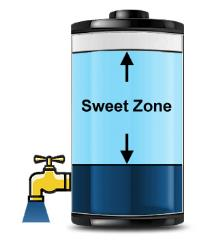How Low can a Battery be Discharged?
Discover what causes short runtimes
Not all battery energy can or should be used on discharge; some reserve is almost always left behind on purpose after the equipment cuts off. There are several reasons for this.
Most mobile phones, laptops and other portable devices turn off when the lithium-ion battery reaches 3.00V/cell on discharge. At this point the battery has about 5 percent capacity left. Manufacturers choose this voltage threshold to preserve some energy for housekeeping, as well as to reduce battery stress and allow for some self-discharge if the battery is not immediately recharged. This grace period in empty state can last several months until self-discharge lowers the voltage of Li-ion to about 2.50V/cell, at which point the protection circuit opens and most packs become unserviceable with a regular charger.
Power tools and medical devices drawing high current tend to push the battery voltage to an early cut-off prematurely. This is especially apparent at cold temperatures and in cells with high internal resistance. These batteries may still have ample capacity left after the cutoff; discharging them with a battery analyzer at a moderate load will often give a residual capacity of 30 percent. Figure 1 illustrates the cut-off voltage graphically.
 |
Figure 1: Illustration of equipment with high cut-off voltage.
Portable devices do not utilize all available battery power and leave some energy behind.
|
To prevent triggering premature cutoff at a high load or cold temperature, some device manufacturers may lower the end-of-discharge voltage. Li-ion in a power tool may discharge the battery to 2.70V/cell instead of 3.00V/cell; Li-phosphate may go to 2.45V/cell instead of 2.70V/cell, lead acid to 1.40V/cell instead of the customary 1.75V/cell, and NiCd/NiMH to 0.90V/cell instead of 1.00V/cell.
Industrial applications aim to attain maximum service life rather than optimize runtime, as it is done with consumer products. This also applies to the electric powertrain; batteries in a hybrid cars and electric vehicle electric vehicles are seldom fully discharged or charged; most operate between 30 and 80 percent state-of-charge when new. This is the most effective working bandwidth; it also delivers the longest service life. A deep discharge to empty followed a full charge would cause undue stress for the Li-ion. Similarly, satellitesuse only the mid-band of a battery called the “sweet zone.” Figure 2 illustrates the “sweet zone” of a battery.
 |

Figure 2: Sweet zone of a Lithium-ion battery to extend life. Operating Li-ion in the “sweet zone” prolongs battery life because a partial cycle is less stressful than a full cycle. As the capacity fades with use, the battery management system (BMS) may engage the full working range of the battery.
|
Elevated internal resistance makes alkaline and other primary batteries unsuitable for high load applications. The resistance rises further as the cell depletes. This causes an early cutoff with the device drawing some current, and much energy is left behind. Primary batteries have high capacities and perform well when new, but they soon lose power like a deflating balloon.


